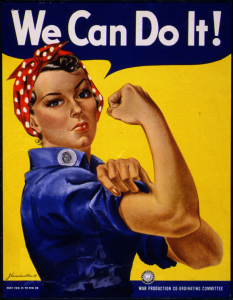 During World War II, millions of American women were called to action; the war effort needed them to fill traditionally male dominated roles in factories and shipyards. The effort provided women the opportunity to see they could do men’s work and laid the groundwork for a women’s social movement that is still on-going today. Now is the time for another female call to action, this time it is to fight the battles against social problems; to save our education system, to end human hunger, and to save our environment. Women philanthropists are needed and these wars cannot be won without them.
During World War II, millions of American women were called to action; the war effort needed them to fill traditionally male dominated roles in factories and shipyards. The effort provided women the opportunity to see they could do men’s work and laid the groundwork for a women’s social movement that is still on-going today. Now is the time for another female call to action, this time it is to fight the battles against social problems; to save our education system, to end human hunger, and to save our environment. Women philanthropists are needed and these wars cannot be won without them.
While strides have been made, women are still severely underrepresented in the social sector. Men still hold majority of the board and leadership positions at non-profits, make important donor decisions, and play more visible and active community roles. While it is important to have men involved too, the lack of women in positions of action, power, and leadership represents a serious missed opportunity for the social sector. Women are desperately needed in droves because they have a uniquely female approach to philanthropy. Their approach is characterized by a number of profound differences from men:
- Women give to different causes—In general, women are more likely to give to educational causes, human services, children, health related charities, the environment and international causes (Piper & Schnepf 2008; Bekkers, 2007). Men are more likely to give to sports and recreational groups or to causes where they will receive social returns (Andreoni, Brown & Rischall 2003; Kottasz 2004). To me, the implication of this kind of giving is obvious.
- Women give more—A variety of studies (Mesch et al, 2006, Piper and Schnepf 2008, Simmon and Emanuele, 2007) have shown that women are more likely to give and to give more across all charitable subsector and income levels. For a sector that is always resource starved, women’s gifts of time, treasure and talent are waiting to be used.
- Women leverage networks and groups—Women are generally more social than men and often join giving circles and nonprofit networks to enhance their philanthropy. Larger pools of capital and talent increase the power and leverage of philanthropic gifts, no matter what kind. In addition, groups provide opportunities for knowledge sharing and skill building, enhancing women’s understanding of and value to the social sector. It has also been found that people who give in a group are more likely to give more.
- Women volunteer more—Volunteering provides the opportunity for to learn firsthand about organizations, their challenges, and their needs. Philanthropists who understand organizations and issues at this deep level have a greater opportunity to be a part of the solution to vexing challenges
All of these factors mean that women approach philanthropy very differently than men and can add a lot of value that is currently missing in the social sector. Consider the problems we might have already solved if women were more active in the causes they care about. The social sector desperately needs talented, women who think and act differently than their male counterparts and who can add fresh perspectives. If you are a woman and have thought about getting involved or deepening your work in the social sector consider this your call to action. Women provide unique value that can help move the needle on challenging social issues. Consider the many causes that will be better funded by female donors, the networks of people that will be spreading more messages, and the social problems that will better understood by their volunteers and supporters when more women get involved.[/fusion_text]


Leave A Comment
You must be logged in to post a comment.